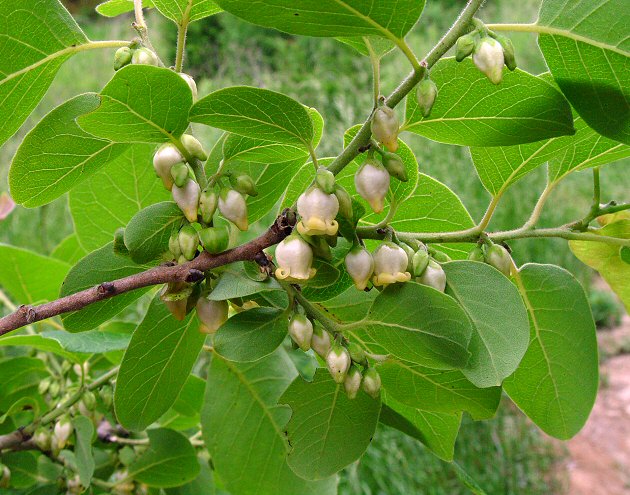Diospyros virginiana L.
Persimmon

Native
CC = 3
CW = 0
MOC = 75
© DETenaglia
Diospyros virginiana L.Persimmon | |
 |
Native CC = 3 CW = 0 MOC = 75 |
© DETenaglia |
|
Family - Ebenaceae Habit - Dioecious, usually trees to 15 m tall, occasionally shrubs only 1-4 m tall, often suckering from the roots to form colonies. Stems - Mature bark deeply furrowed and often also separating into small knobby blocks with age, dark brown to dark gray or nearly black. Twigs dark gray to brown, usually hairy, with reddish-brown solid pith, the winter buds ovate, bluntly pointed at the tip, with 2 main scales.
Leaves - Alternate, simple, petiolate. Petioles to 2 cm long, densely pubescent with short and long hairs, light green. Blades to 15 cm long, 8 cm broad, ovate, tapered to a sharply pointed tip, narrowed, rounded, or cordate at the base, the margins entire, the surfaces glabrous or more commonly sparsely to densely pubescent with short hairs.
Inflorescence - Axillary, solitary or (with staminate flowers only) in small clusters of 2 or 3 flowers. Peduncle to 3 cm long, densely pubescent. Pedicels to 3 cm long, densely pubescent with short and long hairs. Central flower of the inflorescence flowering first. Flowers - Mostly imperfect, actinomorphic, hypogynous, the staminate flowers appearing somewhat perigynous, short-stalked. Calyces 3.0-3.5 mm (staminate) or 7.0-7.5 mm (pistillate) long, deeply 4-lobed, the lobes ovate to broadly ovate, hairy (at least on the inner surface), those of the pistillate flowers broader, persistent, and usually becoming papery and reflexed at fruiting. Corollas 5.5-9.0 mm (staminate) or 10-16 mm (pistillate) long, broadly urn-shaped, with short, spreading lobes, the tube pale yellow, the lobes with the inner surface darker yellow. Staminate flowers with a rudimentary nonfunctional pistil and usually 16 stamens, these about as long as the corolla tube, the filaments very short, hairy, attached in 2 rows toward the base of the corolla tube, the anthers attached at their bases, linear, dehiscing longitudinally. Pistillate flowers with 6-10 short, stamenlike staminodes and a single pistil, this with 8 locules. Ovary superior, of 4 fused carpels. Style 1, 4-lobed to below the midpoint, the stigmas capitate. Ovules 1 per locule.
Fruits - Berries, 2-5 cm in diameter, depressed-globose, the surface glabrous, smooth or somewhat wrinkled with age, ripening to yellowish orange or yellowish brown, sometimes pinkish- or reddish-tinged, less commonly dark purple to bluish purple, usually somewhat glaucous. Seeds 3-6 per fruit, 18-20 mm long, oval in outline, flattened, the surfaces finely granular, reddish brown.
Flowering - May - June. Habitat - Forests, savannas, glades, fields, roadsides, and disturbed areas, clearings. Origin - Native to the U.S. Lookalikes - None. Other info. - This species can be found throughout Missouri except for the northwestern corner of the state. It also occurs throughout the southeastern quadrant of the continental U.S. The tree is easy to identify from its distinctive blocky bark, which appears fairly early in the plant's lifetime. The flowers are also unique. The fruits are a real treat, but only when they are very soft and ripe (usually this means after they have fallen from the tree). Unripe fruits are inedibly astringent. Though the fruits are tasty when eaten out of hand, many people consider them best when baked into breads, muffins, and cookies, or made into ice cream, jellies, pies, puddings, or syrup. The pulp can be frozen for later use. The fruits don't keep long after being picked but can remain on the trees a long time, through much of the winter. Wildlife such as raccoons and opossums are also fond of the fruits, and small piles of scat containing persimmon seeds are a familiar sight in the fall. Photographs taken at Guntersville State Park, AL., 5-22-04, and off Lee Rd 54, Auburn, AL., 10-2-04 (DETenaglia); also at Pacific Palisades Conservation Area, MO, 5-10-2012, along the Katy Trail near Dutzow, Warren County, MO, 10-17-2013, Little Lost Creek Conservation Area, Warren County, MO, 6-6-2018, and Weldon Spring Conservation Area, St. Charles County, MO, 3-5-2020 (SRTurner). |